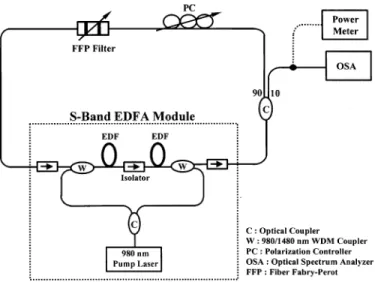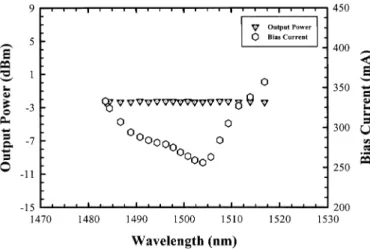IEEE PHOTONICS TECHNOLOGY LETTERS, VOL. 15, NO. 8, AUGUST 2003 1053
A Tunable
S-Band Erbium-Doped Fiber Ring Laser
Chien-Hung Yeh, Chien-Chung Lee, and Sien Chi
Abstract—In this paper, we experimentally investigate and demonstrate an -band erbium-doped fiber (EDF) ring laser based on an erbium-doped silica fiber and 980-nm pumping laser. Widely tunable range from 1480 to 1522 nm, and the sidemode suppression ratio (SMSR) of 30 dB/0.1 nm and the output power of 2 dBm in the operating range from 1482 nm to 1517 nm have been achieved for this ring laser. Under the constant power control, the output power variation less than 0.05 dB can also be accomplished over the tuning range from 1482 to 1517 nm. This -band EDF ring laser is promising for the future -band applications.
Index Terms—EDF, fiber ring laser, -band.
I. INTRODUCTION
E
RBIUM-DOPED FIBER (EDF) ring lasers are applicable to loss measurements of optical components, optical sensing systems, and tunable transmitters in wavelength-di-vision-multiplexing (WDM) systems. Due to the bandwidth limitation of erbium-doped fiber amplifiers (EDFAs), the wavelength range of erbium-doped fiber ring lasers can only cover both - and -bands (1530–1610 nm) [1]–[3]. Recently, an -band (1450–1530 nm) amplification technique, which utilizes erbium-doped silica fiber with depressed cladding design and 980-nm pump laser to generate EDF gain extension effect, has been reported [4]. By using this -band amplifier, the operating wavelengths of EDF ring lasers can be extended to -band range.In this letter, we have experimentally investigated and demon-strated the feasibility of a tunable -band ring laser by using the similar configuration for - and -band ring lasers. The per-formances of tunable range, output power, sidemode suppres-sion ration (SMSR), and constant gain control have also been studied.
II. EXPERIMENTS ANDDISCUSSIONS
Fig. 1 shows the experimental setup for the tunable -band EDF ring laser. This configuration was constructed by a 1 2 and 10:90 optical coupler, an polarization controller (PC), an intracavity fiber Fabry–Pérot filter (FFP-TP), and an -band EDFA module composed of two stage EDFA and a power-sharing 980-nm pump laser. The -band EDF inside EDFA module has a depressed cladding design in order to
Manuscript received March 17, 2003; revised April 30, 2003. This work was supported in part by the Academic Excellence Program of R.O.C. Ministry of Education under Contract 89-E-FA06-1-4-90X023, and the National Science Council of R.O.C. under Contract NSC-91-2215-E-009-027.
The authors are with the Institute of Electro-Optical Engineering, Na-tional Chiao-Tung University, Hsinchu 30050, Taiwan, R.O.C. (e-mail: depew.eo89g@nctu.edu.tw).
Digital Object Identifier 10.1109/LPT.2003.815314
Fig. 1. The experimental setup for anS-band EDF ring laser.
provide a sharp, high-attenuation, long-wavelength cutoff filter into active fibers. The erbium-doped fibers in the first and second stages have different characteristics. The fiber in the first stage has the fiber length of 20 m, and can provide low noise figure and medium gain by forward pumping. The fiber in the second stage has the fiber length of 30 m, and can produce large output power by backward pumping. In addition, the optical isolator between these two stages can reduce backward amplified spontaneous emission (ASE) and improve noise figure performance. The gain and noise figure can reach 32 dB and 5.7 dB at 1500 nm for input power of 25 dBm, and the saturated output power at 1500 nm can be up to 14 dBm for input power of 0 dBm. The total pump power of this amplifier module can be up to 280 mW while the bias current is operated at 356 mA. The FFP filter is an all-fiber device having a widely tunable range, low insertion loss ( 0.5 dB), and low polarization-dependent loss ( 0.1 dB). This FFP filter having the free spectral range (FSR) of 44.5 nm and the finesse of 200 nm can provide wavelength selection in the ring laser cavity by applying external voltage ( 12 V) on the piezoelectric transducer (PZT) of FFP filter. In addition, an optical spectrum analyzer (OSA) and a power meter (PM) are used to measure the output spectra and powers of the ring laser. Fig. 2 shows the optical spectra of this EDF ring laser while the various external-voltage applied on the PZT of FFP filter. The lasing wavelength tuning over 42 nm from 1480 to 1522 nm is observed. The ring laser has ASE and high output power at the high gain region near 1508 nm. Furthermore, the insert of Fig. 2 is the ASE spectrum of the -band amplifier. Fig. 3 represents the output power and SMSR versus the tuning wavelength for this ring laser. The maximal output power of 5.1 dBm occurs at around 1498 nm, and the output powers drop to 3.0, 6.0,
1054 IEEE PHOTONICS TECHNOLOGY LETTERS, VOL. 15, NO. 8, AUGUST 2003
Fig. 2. The optical spectra of tuning wavelength in the EDF fiber ring laser when the external-voltage applied on the PZT of FFP filter over a tuning range from 1480 to 1522 nm. The insert is the ASE spectrum of anS-band EDFA module.
Fig. 3. The output power and SMSR versus the tuning wavelength for this ring laser over the tunable range from 1480 to 1522 nm.
and 11.0 dBm while operating at 1480, 1520 and 1522 nm, re-spectively. As seen in Fig. 3, the SMSR and output power can be kept larger than 30 dB/0.1 nm and 2.0 dBm in a wide tuning range over 34 nm (1482–1517 nm). When the lasing wave-length operated at around 1508 nm, the SMSR will increase dramatically to 64.2 dB/0.1 nm due to the strong gain com-petition and ASE compression. As a result, the tunable range over 42 nm (1480–1522 nm) can be achieved and the SMSR of 30 dB/0.1 nm and the output power of dBm can be kept in the operating region from 1482 to 1517 nm for this EDF ring laser.
Furthermore, the constant output power control for this ring laser can be obtained by proper adjustment of the bias current of the pump laser in the -band amplifier. Fig. 4 indicates the
Fig. 4. The constant output power (set at02.3 dBm) and various bias current (255–356 mA) of the pump laser versus lasing wavelength for this ring laser in the tuning range from 1482 to 1517 nm.
output power and bias current of the pump laser versus lasing wavelength for this ring laser. In Fig. 4, we set the constant output power of this ring laser at 2.3 dBm. The power vari-ation less than 0.05 dB can be obtained in the tuning range from 1482 to 1517 nm by tuning the bias current from 255 to 356 mA.
III. CONCLUSION
In summary, an -band EDF ring laser based on an erbium-doped silica fiber and 980-nm pumping laser have been exper-imentally investigated and demonstrated. Widely tunable range from 1480 to 1522 nm, and the SMSR of 30 dB/0.1 nm and the output power of 2 dBm in the operating range from 1482 to 1517 nm have been achieved for this ring laser. Under the constant power control, the output power variation less than 0.05 dB can also be accomplished over the tuning range from 1482 nm to 1517 nm. This -band EDF ring laser is promising for the future -band applications.
ACKNOWLEDGMENT
Authors would like to thank C.-Y. Chen for help on experi-ments.
REFERENCES
[1] Y. Sun, J. W. Sulhoff, A. K. Srivasta, J. L. Zyskind, T. A. Strasser, J. R. Pedrazzani, C. Wolf, J. Zhou, J. B. Judkins, R. P. Espindola, and A. M. Vengsarkar, “80 nm ultra-wideband erbium-doped silica fiber ampli-fier,” Electron. Lett., vol. 33, no. 23, pp. 1965–1967, 1997.
[2] L. Talaverano, S. Abad, S. Jarabo, and M. Lopez-Amo, “Multiwave-length fiber laser sources with Bragg-grating sensor multplexing capa-bility,” J. Lightwave Technol., vol. 19, pp. 553–558, Apr. 2001. [3] S. Yamashita and M. Nishihara, “Widely tunable erbium-doped fiber
ring laser covering both C-band and L-band,” IEEE J. Select Topics
Quantum Electron, vol. 7, pp. 41–43, Jan./Feb. 2001.
[4] M. A. Arbore, Y. Zhou, G. Keaton, and T. Kane, “34 dB gain at 1500 nm in S-band EDFA with distributed ASE suppression,” in 28th ECOC

